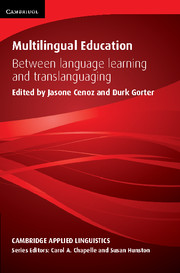Book contents
- Frontmatter
- Contents
- List of contributors
- Series editors’ preface
- Acknowledgements
- 1 Towards a holistic approach in the study of multilingual education
- 2 L1 as a pedagogical resource in building students’ L2 academic literacy: pedagogical innovation in the science classroom in a Hong Kong school
- 3 Linking content, linking students: a cross-linguistic pedagogical intervention
- 4 The role of the native language in the literacy development of Latino students in the United States
- 5 A nexus analysis of code choice during study abroad, and implications for language pedagogy
- 6 Multilingual practices in foreign language study
- 7 Language choices and ideologies in the bilingual classroom
- 8 Communicative repertoires in the community language classroom: resources for negotiating authenticity
- 9 Complementary classrooms for multilingual minority ethnic children as a translanguaging space
- 10 Constructing in-between spaces to ‘do’ bilingualism: a tale of two high schools in one city
- 11 Becoming multilingual and being multilingual: some thoughts
- Index
2 - L1 as a pedagogical resource in building students’ L2 academic literacy: pedagogical innovation in the science classroom in a Hong Kong school
Published online by Cambridge University Press: 17 September 2021
- Frontmatter
- Contents
- List of contributors
- Series editors’ preface
- Acknowledgements
- 1 Towards a holistic approach in the study of multilingual education
- 2 L1 as a pedagogical resource in building students’ L2 academic literacy: pedagogical innovation in the science classroom in a Hong Kong school
- 3 Linking content, linking students: a cross-linguistic pedagogical intervention
- 4 The role of the native language in the literacy development of Latino students in the United States
- 5 A nexus analysis of code choice during study abroad, and implications for language pedagogy
- 6 Multilingual practices in foreign language study
- 7 Language choices and ideologies in the bilingual classroom
- 8 Communicative repertoires in the community language classroom: resources for negotiating authenticity
- 9 Complementary classrooms for multilingual minority ethnic children as a translanguaging space
- 10 Constructing in-between spaces to ‘do’ bilingualism: a tale of two high schools in one city
- 11 Becoming multilingual and being multilingual: some thoughts
- Index
Summary
Introduction
The topic of medium of instruction (MOI) has long been an important site of contestation in Hong Kong. Owing to its high socioeconomic status and its gate-keeping function in higher education, Englishmedium instruction (EMI) has been keenly sought after by parents for their children since the 1980s. Indeed, English was widely adopted as the medium of instruction in secondary schools despite the fact that Chinese was granted the status of an official language in 1974. In 1960, for example, only 57.9% of the secondary schools in Hong Kong were English-medium schools, but by 1980, 87.7% of them had adopted English as their MOI (Bray & Koo, 2004 ).
In 1978, the introduction of compulsory nine-year education in Hong Kong meant that many students who formerly could not enter secondary schools were receiving their education in EMI schools. In these EMI schools many teachers adopted a bilingual approach in which they switched between Chinese (practised as spoken Cantonese and written Standard Chinese), the home languages of the students, and English, their L2, because many students were not capable of learning through English alone. This approach was regarded by the Hong Kong government as unproductive, and in 1998 the government adopted a linguistic streaming policy which allowed only 114 secondary schools to use EMI in their junior forms (Forms 1–3; equivalent to Grades 7–9), whereas the rest of the schools (about 70%) had to change to Chinese-medium instruction (CMI) in their junior forms (schools still retain their autonomy to choose the medium of instruction for senior forms). This policy, however, met with a great deal of opposition, mainly from parents who believed that this practice only deepened the stigmatization of Chinese-medium schools by suggesting that they were for the less competent, and who wanted access to EMI for the sake of their children's future jobs and the higher educational opportunities it afforded them. Amidst political pressure, a fine-tuned MOI policy was implemented by the government in September 2010.
The fine-tuned MOI policy for secondary schools
Since September 2010, many CMI schools have chosen to change the medium of instruction of one or two of their academic subjects (usually science or mathematics), or some percentage of the lessons of each of their academic subjects, from CMI to EMI, also because of strong parental demand for English for their children.
- Type
- Chapter
- Information
- Multilingual EducationBetween Language Learning and Translanguaging, pp. 16 - 34Publisher: Cambridge University PressPrint publication year: 2015
- 11
- Cited by



